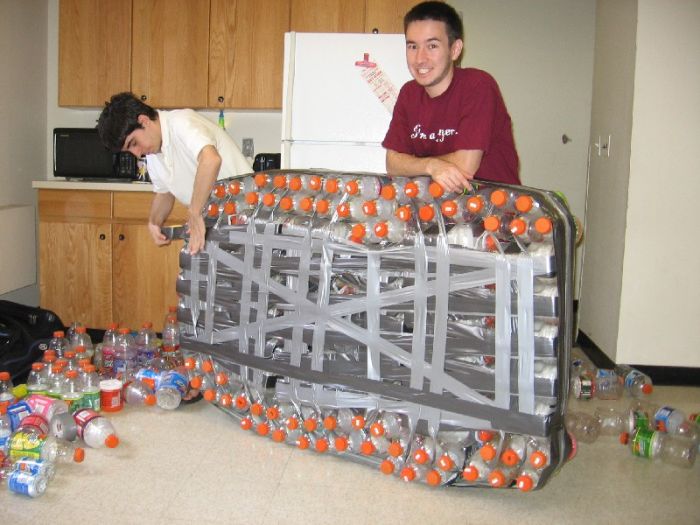CONTEMPORISTLos Angeles Modernism Show & Sale - May 2008
Dates & Times:
02 May - Gala Opening Party - 6pm to 9pm
03 May - Regular Show - 11am to 7pm
04 May - Regular Show - 11am to 5pmWhere: Santa Monica Civic Auditorium - 1855 Main Street, Santa Monica (California).
Further information is available at their website.
If there is anyone out there that is thinking of going, we would love to see some photos!
Armchairs That Create Style with Wood
The Riviera Armchair, spotted at City Living.
This is the C-Chair from Modernica.
These are the Eva Chairs from Property.
House in Los Angeles, California
If you’re interested in buying a home in Los Angeles, you’re in luck! This house in the Hollywood Hills is for sale at the low low price of $4.5 million, but before you go searching for coins under your sofa cushions in a desperate attempt to gather enough money for a down payment, click on through to see all the photos:
Public Art Sculpture in Queensland, Australia
This is the Position Sculpture created by Pavel Perina and Hana Perinova. It is made from eucalyptus branches and tree bark wrapped around steel construction and it was part of the Currumbin Sculpture Festival in Queensland, Australia.
5 Fabulous Floor Lamps
The Honey F1 Floor Lamp by Dante Donegani & Giovanni Lauda. Spotted at Rotaliana.
The Ondalina P Floor Lamp designed by Christophe Mathieu. Spotted at Marset.
The Aphrodite, Artemis & Athena floor lamps by Fabrice Berrux. Spotted at Dix Heures Dix.
Pod Living
The PerrinePod is a modular stackable prefab home designed by the Perth, Australia based architect Jean-mic Perrine. You can drop one (or more) of these self-contained pods anywhere and be livin in style within a few days!
Six Eye-Catching Bathtubs
On most peoples’ priority list for interior design, bathtubs unfortunately don’t rank very high, but here are six wow-worthy bathtubs that we could really get into.
The Milo Bath designed by Alessandro Lenarda. Spotted at Gruppo Treesse.
The Calypso Ciliegio Bath designed by Alessandro Lenarda. From Gruppo Treesse.
The Inside designed by Fabrizio Batoni. Spotted at Gruppo Treesse.
No Squares Here!
Looks like someone was paying attention in geometry class and learned a little about quadrilateral trapeziums. That someone would be the people at Lunde & Løvseth Architects who designed this unique doorway at the Norwegian Petroleum Museum in Stavanger, Norway.
Four Twisted Tables
The Tosai Round Table designed by Peter Maly. Spotted at Conde House.
This is the Argon Coffee Table from The Lavassa Line. Created by Peter Harrison.
This is the Orange Twist Table by PK Steel Furniture.
The Discu Table in black created by Dirk Winkel.
Interior Inspiration
Thanks to Samantha for letting us know about this apartment in Cape Town, South Africa.
Designed by Peerutin Architects
House in Minneapolis, Minnesota
This 3 bedroom/3 bathroom prefab “Weehouse” designed by Alchemy Architects is an excellent example of a realistic contemporary house design. I use the word realistic because unlike the many amazing architectural masterpieces we’ve featured on Contemporist, this is more affordable and accessible to the average homebuilder.
Perhaps designs like this will replace the current popularity of McMansions as the
standard house design?
New Chair & Ottoman from West Elm
This is the New Random Weave Chair & Ottoman made from natural abaca bark that is woven around a metal frame. Available at West Elm.
Townhouses in Memphis, Tennessee
Besides their clean lines and simple elegance, I really enjoy how these townhouses choose to interact with the street instead of retreating away from it.
New Items from Nambe!
Nambé have just launched their 2008 Spring Line and there are some great pieces from designer Neil Cohen, including the Lounge Illume (top) and the Lounge Solo (bottom).
INTERESTING THINGS FOR YOU LATE @ NIGHT PART 1 + 3 (ULTIMATE EXPANSION)
Japan Video Games Blog
Disclaimer
We're not making money off the site, nor are we publishing anything to other places through feedburner claiming that it's our work, just a hobby of finding cool things around the internet, that's all. Sometimes we copy and paste too quickly and a link giving you credit doesn't appear, if that's the case and you DO want your work promoted, we will add in the backlink, we would love to give credit where credit is due!
Please contact me or drop a comment on any posts you guys don't want up and I'll take it off within 24 hours, thanks!
Sunday, April 13, 2008
CONTEMPORIST - THEY ARE AWESOME, PLEASE CHECK OUT THEIR BLOG AT THE END OF THE POST
Shambhala Sun - Looking into Laziness
Rather than feeling discouraged by laziness, we could get to know laziness profoundly. This very moment of laziness becomes our personal teacher.Shambhala Sun - Looking into Laziness
Traditionally, laziness is taught as one of the obstacles to awakening. There are different kinds of laziness. First, there’s the laziness of comfort orientation, we just try to stay comfortable and cozy. Then there’s the laziness of loss of heart, a kind of deep discouragement, a feeling of giving up on ourselves, of hopelessness. There’s also the laziness of couldn’t care less. That’s when we harden into resignation and bitterness and just close down.
Comfort Orientation
Comfort orientation comes in a variety of forms. Sogyal Rinpoche writes that in the East, for example, laziness often manifests as flopping down in the sun with one’s cronies, drinking tea, and letting the days pass by. In the West, he observes, laziness frequently manifests as speed. People rush from one thing to another, from the gym to the office to the bar to the mountains to the meditation class to the kitchen sink, the backyard, the club. We rush around seeking, seeking, seeking comfort and ease.
Whether we flop or rush, and wherever on the globe we happen to be, the comfort-orientation brand of laziness is characterized by a profound ignoring. We look for oblivion: a life that doesn’t hurt, a refuge from difficulty or self-doubt or edginess. We want a break from being ourselves, a break from the life that happens to be ours. So through laziness we look for spaciousness and relief; but finding what we seek is like drinking salt water, because our thirst for comfort and ease is never satisfied.
Loss of Heart
The laziness of loss of heart is characterized by vulnerability, woundedness, and not knowing what to do. We tried just being ourselves and we didn’t measure up. The way we are is not okay. We chased after pleasure and found no lasting happiness. We took time off, went on vacation, learned to meditate, studied spiritual teachings, or spent years dedicated to certain political or philosophical views. We helped the poor or saved the trees or drank or took drugs, and we found no satisfaction. We tried and we failed. We came to a painful, hopeless place. We don’t even want to move. We feel we could gladly sleep for a thousand years. Our life feels meaningless. Loss of heart is so painful that we become paralyzed.
Couldn’t Care Less
Couldn’t care less is harder, more icy, fatalistic. This particular flavor of laziness has an edge of cynicism and bitterness. We feel that we just don’t give a damn anymore. We feel lazy and mean at the same time. We feel mean toward this disappointing and lousy world, and toward this person and that person. Mostly we feel mean toward ourselves. We made a mistake. We’re not exactly sure what this mistake was, but we got it all wrong; and now, to hell with it! We try to forget in any way we can. We stop doing much. We feel as if we can’t do much anyway, and frankly, we don’t care.
So What To Do?
Built into the human predicament seems to be the assumption that we should eliminate our failings; as adequate and worthy people, we should be able simply to leap over our weaknesses. So perhaps the grown-up thing to do would be to blow up laziness with a bomb, or drop it into the Atlantic Ocean with a huge weight so it would never reappear, or send it off into space so that it would float out into infinity and we’d never have to relate to it again.
But if we ask ourselves, Where does joy come from? Where does inspiration come from?, we will find they do not come from getting rid of anything. They do not come from dividing ourselves in two and struggling against our own energy. They do not come from seeing laziness as an opponent, or something out there that we should leap over. They do not come from denigrating ourselves.
The path of awakening is a process. It’s a process of gradually learning to become intimate with our so-called obstacles. So rather than feeling discouraged by laziness, we could look into our laziness, become curious about laziness. We could get to know laziness profoundly.
We can unite with laziness, be our laziness, know its smell and taste, feel it fully in our bodies. The spiritual path is a process of relaxing into this very moment of being. We touch in with this moment of lethargy or loss of heart, this moment of pain, of avoidance, of couldn’t care less. We touch in and then we go forward. This is the training. Whether in formal meditation or throughout our days and nights, we can train in letting go of our commentary and contacting the felt quality of our experience. We can touch our experience without getting hooked by the story line. We can touch this very moment of being and then move on.
We are sitting in meditation or going about our usual routine, and it occurs to us to listen to what we’re saying. What we hear is, Oy vey, oy vey! Woe is me. I’m a failure. There’s no hope. We look at what we do to ourselves, what we say to ourselves, how we lose heart or try to distract ourselves. Then we let those words go and touch the heart of this moment. We touch the very center of this moment of being and then we let go. This is how we train. Again and again, this is our practice.
We join our loss of heart with honesty and kindness. Instead of pulling back from the pain of laziness, we move closer. We lean into the wave. We swim into the wave.
Somewhere in the process of staying with the moment, it might occur to us that there are a lot of unhappy brothers and sisters out there, suffering as we are suffering. In becoming intimate with our own pain, with our own laziness, we are touching in with all of them, understanding them, knowing our kinship with all of them.
We are sitting in front of the television eating chips, drinking beer, smoking cigarettes. Hour after hour after hour we sit there. Then for some reason, we see ourselves clearly. We have the choice to eat the tenth bag of chips and watch the sixteenth sitcom, or to relate with our depression and laziness in an honest and openhearted way. Instead of continuing to zone out and shut down and close off, we lean in and relax. This is how we practice.
So maybe we open the window or go out for a walk, or maybe we sit silently, but whatever we do, it occurs to us to stay with ourselves, to go behind the words, behind the ignoring, and to feel the quality of this moment of being, in our hearts, in our stomachs, for ourselves, and for all of the millions of others in the same boat. We start to train in openness and compassion toward this very moment. This very moment of laziness becomes our personal teacher. This precious moment becomes our profound and healing practice.
Pema Chödrön is the director of Gampo Abbey in Cape Breton, Nova Scotia, and author of The Wisdom of No Escape, Start Where You Are and When Things Fall Apart: Heart Advice for Difficult Times.
Blogged with Flock
international travel, tipping, tips, gratuity
international travel, tipping, tips, gratuity
Americans can sometimes be loud, boorish, and extroverted. We’re the class clowns of the world. But we’re also the biggest tippers. We know that clowns are laughing on the outside, but crying on the inside, right? According to Michael Lynn, associate professor of market and consumer behavior at the Center for Hospitality at Cornell University, countries with more “extroverted” and “neurotic” people gave tips to the greatest number of services and also tipped the largest amounts – with the U.S. topping both categories.Based on this reasoning, it makes sense that in countries where decorum, group-thinking and introversion are king, tipping would be low. You’d be right in countries like Japan, where if you tip, it could be seen as a mistake on your part (the waiter may chase you down to tell you that you left money on the table). But how do you explain the lack of tipping in Australia or New Zealand, whose big-mouthed, extroverted drinking culture rivals our own?
So what’s tipping like in the rest of the world?
Germany: When I traveled to Germany a year ago, I remember being told it was not necessary to tip as much as in the U.S. I assumed it was because the Germans were too proud to take tips or something stoic like that (being from hardy German and Polish stock myself). Turns out the waitresses in Germany actually make a livable wage—a monthly salary considerably higher than U.S. minimum wage. So if they get tips from clueless Americans, they get to keep them! Tips are generally less than 10%. Taxi drivers get 10%.
Japan: Tipping is not required and in fact may cause embarrassment or offense to those tipped. If the bellboy stands an extra moment in your hotel room, he’s not waiting for a tip, he’s likely waiting to make sure you get settled in properly. Customer service (*gasp*)!
Singapore: In Singapore, tipping is a way of elevating one’s status. However, the Singapore government does not encourage such tipping-officially.
Traditional after-meal tipping is not usually required as good establishments levy a 10% service charge with the meal. If one wishes to ensure good service when entertaining special guests, one can give an extra 10% of the bill amount to the headwaiter who will share the tip with the other service staff.
Switzerland: Apparently tipping has been ABOLISHED in Switzerland, and a 15% “service charge” has been included in all hotel, restaurant and taxi bills. However, if you had a jolly time and wish to show your appreciation, they are not going to call the cops on you if you leave an extra 10%.
Brazil: Tipping, like the lifestyle in Brazil, is flexible. If you feel like tipping, do. If you don’t, then don’t! Nobody cares! Then have a drink, dahling, you look tired.
England: A service charge of 12.5% is usually included at restaurants. For taxis, a 10% tip is generally expected. The exception is at that British institution, the local pub. If you are impressed with the barkeep’s service, do not tip cash at the bar in a pub. Offer to buy them a drink, like a half pint of beer, or small spirit.
Ethiopia: Tipping is not required, unless you want to show your enjoyment of a dancer, in which case you are to stick a paper bill on their forehead. Which you should only do if the dancer in question has a light film of sweat on their forehead.
Mexico: Tip everyone, if only for karma points because the wages there are dismally low. Figure on 15% for good service at a restaurant. If you’re taking a taxi and speak Spanish, you can negotiate up front for a fare that will include the tip. Oh, and don’t expect that the driver will know where to go better than you. If you find one that does, it’s worth a good tip.
Canada: It’s probably because of its proximity to the U.S. but most service staff in Canada expect something in the 10-20% tip range, depending on what city and the level of service. Tipping differs however depending on whether you are in French or English Canada. Tipping is expected for restaurants, bars, food delivery and taxis In Montreal, tips for a good meal at a good restaurant with good service should be tipped more. In most of English Canada, you would find it a lot harder to have the same experience, and anyway would not be expected to tip as much.
China: Don’t tip anywhere. Try not to think about how you’re generally charged more for everything because you’re a foreigner – by your friendly neighborhood Chinese government.
Hong Kong: Taxi drivers do not expect tips (which is a darn good thing as they mostly don’t deserve them) unless they are taking you to the airport or the MTR station which connects with the airport, when the cost of carrying luggage mysteriously multiplies.
Italy: No tip is expected in restaurants throughout Italy. If you feel guilty, just remember that you are being charged a coperto (’cover charge’) or possibly for pane (’bread’), as well. If you’re feeling generous, you can leave some coins on the table as you leave.
France, a service charge is usually included in the bill at the end of your meal; if not, 15% is pretty standard. Taxi drivers generally don’t expect to be tipped.
For more geek-level data: check here for a thoroughly anal listing of the dos and don’ts of world tipping.
In general, tip like a Rockefeller in Canada, Chile, Ireland and Egypt (except taxis), and tip like a hobo everywhere else!
Blogged with Flock
The Top 20 Oxymorons | Stoner Guy's Blog
The Top 20 Oxymorons | Stoner Guy's BlogHere are pairs of words that should not be said together. . .yet tend to be said more often than not.
20 - Act Natural
19 - Genuine Imitation
18 - Good Grief
17 - Same Difference
16 - Almost Exactly
15 - Sanitary Landfill
14 - Alone Together
13 - Silent Scream
12 - Living Dead
11 - Small Crowd
10 - New Classic
9 - Sweet Sorrow
8 - “Now, Then”
7 - Passive Aggressive
6 - Taped Live
5 - Clearly Misunderstood
4 - Peace Force
3 - Terribly Pleased
2 - Pretty Ugly. . .and the #1 Oxymoron is. . .
1 - Microsoft Works
Blogged with Flock
6 Ways to Excel in the Workplace
6 Ways to Excel in the WorkplaceA shaky economy has everyone watching their bottom lines. It's no different at work. Persistence helps make you a top performer. Tips from work-a-day winners are outlined below.
Stop Worrying
Wes Moss wrote "Make More, Worry Less" to tell the stories of people achieving extraordinary success by bringing an entrepreneur's mindset to their run-of-the-mill jobs.
One thing they do, Moss says, is work without fear of failure.
One worry-crushing technique? "Ask yourself what the worst-case scenario is," Moss told IBD. "Once you accept that, you can move forward and focus on the task at hand."
Keep Track
Moss calls himself a "corporate entrepreneur" because he works full-time as a certified financial planner at UBS Financial Services while writing business books and hosting a financial radio show on the side.
Moss makes a habit of writing down his successes in a "value log." It helps him frame his accomplishments so he can announce them at work. "If you're great at something, it doesn't matter if no one knows about it," he said. It also helps him track his strengths so he knows where to dedicate his energies.
Close the Door
Ralph Olson was a financial analyst at Pepsi-Cola when a project no one wanted was tossed his way: create an affordable plastic soft drink container consumers would love.
Olson grabbed the corporate hot potato and mentally closed the door on failure. "My thinking was, 'I want it because I think I can make it work,'" he said in Moss' book.
With no turning back, Olson drove the project forward. The now-ubiquitous two-liter plastic bottle led to Olson's promotion to vice president -- the youngest in company history at age 32.
Never Say No
Buddy Newell told Moss he always loved fine timepieces. To excel at selling them, Newell decided he'd always deliver exactly what his wealthy customers wanted.
What they wanted were diamonds. But his employer, PK Time, balked at adding rocks to their watches. So Newell talked the designer into making just one.
Newell sold the diamond-encrusted watch in 10 minutes.
The company developed a jewel-heavy "Buddy" line in his honor, and Newell ticked ahead to vice president of sales.
Perfect Your Image
Ed Cortese decided to operate his career like his own little company, he told Moss.
To project a confident product -- himself -- Cortese dressed flawlessly and used his posture and demeanor to communicate a calm expertise. That approach helped him land his dream job as marketing director for luxury magazine Robb Report.
Just Work Harder
Linda Raab was living paycheck to paycheck as a beverage manager at a Steak 'n Shake restaurant when a customer suggested selling Aflac insurance. Raab lacked contacts because she was new to the area, so she decided to knock on more doors than anybody else -- even selling a policy in a gas station parking lot.
Moss says that's how Raab went from having $456 in the bank to earning a six-figure income.
Blogged with Flock
Nation's Largest Employers
Nation's Largest Employers
Company Employees 1. Wal-Mart 1,800,000 2. McDonald's 447,000 3. United Parcel Service 407,000 4. Sears Holdings 355,000 5. Home Depot 345,000 6. Target 337,000 7. IBM 329,373 8. General Motors 327,000 9. General Electric 316,000 10. Citigroup 303,000 11. Ford Motor 300,000 12. Kroger 289,000 13. Albertson's 240,000 14. United Technologies 222,200 15. Verizon Communications 217,000 16. FedEx 215,838 17. Safeway 201,000 18. Altria Group 199,000 19. Aramark 195,000 20. Berkshire Hathaway 192,012 21. AT&T 189,950 22. Delphi 185,200 23. Bank of America 176,638 24. JP Morgan Chase 168,847 25. Yum Brands 165,920 26. HCA 165,450 27. Lowe's 164,794 28. PepsiCo 157,000 29. Walgreen 155,200 30. Wells Fargo 153,500 31. Boeing 153,000 32. Darden Restaurants 150,100 33. Hewlett-Packard 150,000 34. Gap 150,000 35. JC Penney 150,000 36. Starwood Hotels and Resorts 145,000 37. Marriott International 143,000 38. Sara Lee 137,000 39. Lockheed Martin 135,000 40. Walt Disney 133,000 41. Alcoa 129,000 42. Northrop Grumman 123,600 43. Electronic Data Systems 117,000 44. Honeywell 116,000 45. Johnson & Johnson 115,600 46. Lear 115,113 47. Starbucks 115,000 48. Emerson Electric 114,200 49. CVS 114,000 50. Tyson Foods 114,000
Blogged with Flock
The project of building a raft with bottles!!

Let's start by collecting bottles...



Tying them correctly...



First test successfull!

It's a go!

The project of building a raft with bottles!!
Blogged with Flock















































